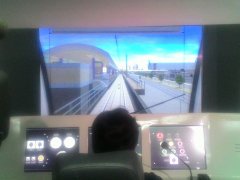News
LRT-2 launches country’s 1st ever train driving simulator

The simulator will allow users to have a driver’s view from the train cab and operate realistic cab controls such as doors, pneumatics, electricals and signaling systems, among others. (PNA photo)
MANILA — The Light Rail Transit Authority (LRTA) has launched Wednesday its train driving simulator which will help improve the driving skills of the train operators of the Light Rail Transit Line 2 (LRT-2) and ensure passenger safety.
The simulator will allow users to have a driver’s view from the train cab and operate realistic cab controls such as doors, pneumatics, electricals and signaling systems, among others.
The facility also enables training on the operations of LRT-2 trains both in normal and degraded conditions including situations not possible in actual train operations.
Train operators will also acquire the necessary skills to react properly and quickly in any potential situation in real train operations.
“The simulator is the first ever in the country. This will be used to enhance the skills of train drivers emphasizing on safety. We also want to ensure the safety of passengers,” LRTA Administrator Reynaldo Berroya told reporters as he unveiled the simulator at the LRT 2 Recto station in Manila.
The train driving simulator reproduces the entire topography of LRT-2 including the line signaling, passenger stations and the Metro Manila landscape exactly simulating the image of the railway system.
The 25 most frequent fault occurrences encountered during actual revenue operations were incorporated into the system providing train operators the correct intervention and troubleshooting practices in a safe and controlled environment.
The equipment is capable of generating reports on the performance of train operators under evaluation or undergoing refresher courses.
It was manufactured by LANDER Simulations and Training Solutions of Spain and delivered to the country by Kempal Construction and Supply Corporation.
The LRTA will hire drivers who will be trained by the Philippine Railway Training Center.
“Our Philippine Railway Training Center (PRTC) has always been on the lookout for an innovative way to conduct training to strengthen LRTA’s goal to be the center in professionalizing the railway industry in the country. We see the use of the simulator as a safe and cost-effective means of teaching train driving so we strived to acquire it,” Berroya said.
“With the unveiling of this state of the art training system, we have taken the training standard into a higher level and we will continue to look for ways to improve standards and to achieve customer satisfaction,” he added.
The Department of Transportation has signed earlier this year a a memorandum of agreement with various academic institutions in creating the country’s first-ever Philippine Railway Institute (PRI)
The proposed railway training facility, which is funded by the Japan International Cooperation Agency, will provide the human and knowledge resources needed to design, build, operate, and maintain the massive railways pipeline under the Duterte administration’s Build, Build, Build program.
It is envisioned to become a training institution and licensing body, which will ensure that all individuals who will operate and maintain the trains, as well as other personnel involved in operations, will have the necessary skills, qualifications, and service-oriented mindset.
The LRTA hopes that the software of the simulator will be adapted by other railway systems such as the LRT Line 1, Metro Rail Transit Line 3 and the Philippine National Railways to further improve their transport services





















